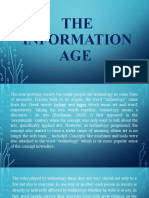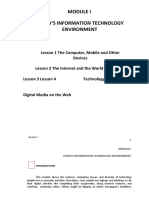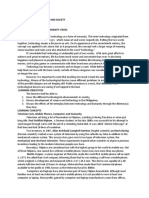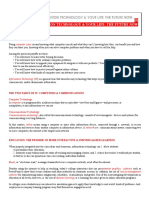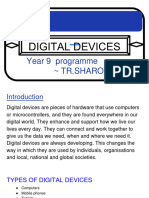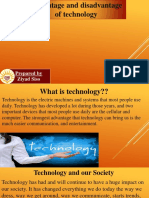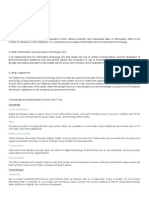0 ratings0% found this document useful (0 votes) 90 views17 pagesEnglish Investigatory Project
Copyright
© © All Rights Reserved
We take content rights seriously. If you suspect this is your content,
claim it here.
Available Formats
Download as PDF or read online on Scribd
OVERUSE OF DIGITAL DEVICES�CONTEN
S.No Particulars Page No
1 Action plan 1
2. Objectives 2
3 Introduction 3-4
4. What are digital devices? 5
5|_ Facts about tech-gadgets and services 6-7
6. Everything has pros and cons. 8-10
7 Physical health effects. ul
8 Addiction. 12
9. Lifestyle 13.
10. Conclusion and Bibliography 14
11 Questionarie 15-16�OBJECTIVES
1. To find out the level of electronic gadget excessive use among adolescents.
2. To find out the level of academic performance among adolescents
excessively using electronic gadget.
3. To find out the level of family interaction among adolescents excessively
using electronic gadget.
4, To find out the relationship between electronic gadget excessive use and
academic performance among adolescents excessively using electronic
gadget.
5. To find out the relationship between electronic gadget excessive use and
Family interaction among adolescents excessively using electronic gadget.
6. To associate the electronic gadget excessive use with their socio
demographic variables such as age, sex, standard, education of parents,
occupation of parents, income of parents, number of children, order of birth,
religion, place of residence, type of family, availability of devices, hobbies,
outdoor activities and social gathering.�INTRODUCTION
In a world that has experienced a technological awakening on a magnitude never
experienced before, even the old have embraced the change. "New" is a word
that might be used to describe Information Technology, but how recent can you
say the field of Information systems. Scholars can argue that the first
“information super highway" before the internet was the ‘Dewey Decimal
System’ used in libraries. Information Technology can be described as using
computers to; store information, manipulate it into different formats, view, play,
or delete digital files with the ability to transmit the information to different
locations. The study of what makes this gadget tick what makes the internet
work, and what makes this phone's camera better than that other one, explains
the phenomenon which is these things we dedicate so much time to staring into
them for hours on end. Applying technology to our day to day to life and how it
can make everyday tasks easier and even enjoyable: taking a jog while listening
to music on your mp3 player. Knowing the inner working the set this machines
and systems is the simple definition of Information Technology.
Computers are the backbone that facilitates Information technology which has
been adapted from the larger school of Information and Communication
Technology. Take the example of your smart phone basically these days even a
3-year-old has access to one of these. A smartphone is a small computer with
specialized features to facilitate making calls.
Over a decade, cell phones have been a necessity to people of all ages. Even
more recently. Smart phones have come out, allowing for easy access to the
internet. This has led to massive adoption of cell phones into everyday life.
People rely on these devices every day, for school, work, directions, health, and
much more. The constant use of cell phones, however, has raised many
questions, especially when it comes to teenagers. Many parents wonder about the
health and social risks of cell phones. There are pros and cons to cell phone
usage by teenagers�Before the invention of smartphones and wearable smart devices, computer
usage was mostly limited to PC and laptop usage. However, now that smart
devices have proliferated the market and people of all ages can access the web
in countless ways, it's more convenient than ever to spend time on a virtual
device. And, many people don't just spend time looking at one screen per day.
they look at many.
‘Think, with Google showed that 80% of users look at a smartphone daily, and
57% of people use more than one device with a screen each day. Only 14% get
online with a computer (laptop or PC only)-meaning that computer usage isn't
just limited to an office, classroom, or desk, but can happen anywhere a person
is-increasing the chances of spending a significant portion of their life online.
DIGITAL DEVICES
[Users lookat a phone dally
D Users who use more than one
device with a screen each day
users who get online only with 2
computer
Screen usage can be both good and bad. When people get online, they can be
doing work or classwork. They can be corresponding with friends who live far
away or watching/listening to a new and exciting film or album release.
However, screen time can also negatively impact a person's mental health for a
myriad of reasons. Learn both how using digital devices can benefit people's
well-being and how it can also detract from people's mental wellne:�>
v
v
v
v
v
WHAT ARE DIGITAL DEVICES?
The term “digital” is derived from the Latin word digitus, which means
“finger,” and relates to one of the oldest tools for counting!
Digital technology is a process that starts at the bottom and works its way
up. Digitized information is stored in binary code, which is made up of
combinations of the digits 0 and 1, also known as bits, and represents
words and images.
Massive volumes of information may now be compressed on compact
storage devices that can be readily stored and transported thanks to digital
technology.
Data transmission speeds are also increased as a result of digitization.
People’s communication, leaming, and working practices have been
revolutionised by digital technology.
Because everything nowadays is dependent on computers in some way, the
term “digital technology” is a rather broad term that covers a lot of
terrains. People are probably utilising digital technology from the time you
get up until you go to bed, and even when you are asleep.
All electronic instruments, automated systems, technical gadgets, and
resources that generate, store, or process data are considered digital
technologies. Some digital devices:
Cell phones
Laptops and PCs
PlayStations and Videogames
Y Televisions�DIGITAL DEVICE
MOBILE/CELL PHONE
Mobile phone or cell phone is a device that can make and receive telephone
calls over a radio link while moving around a wide geographical area. Besides
telephony it can also provide a variety of other services like text messaging,
playing music, e-mail, internet access, infrared, Bluetooth, business
applications, gaming and photography ete. It was first introduced in 1973 and
in 1983 the first mobile phone was commercially available .From 1990 to
2011, the number of world-wide mobile phone users grew from 12.4 million
to over 6 billion, covering about 87% of the global population.
COMPUTER/LAPTOP
Computer is a general purpose device that can be programmed to carry out a
finite set of erythematic and logical operations. Computer can solve more than
one kind of problem at a particular time as a sequence of ope!
tions can be
readily changed. A laptop is a type of computer that can be folded and easily
carried out due to its’ small size and battery support for energy, required to
run it, The first laptop was invented in 1979 by British Designer Bill
Maggridge. For the laptop producers the year 1989 was quite successful. Now
the laptops are generally used for making programs, storing data,
entertainment (music, videos), accessing net etc. Currently the number of
computer users in the world is 900 million to 1 billion i.e. around 80% of the
world population are using or having computers.
SMART PHONE
A smartphone, or smart phone, is a type of mobile phone built on a mobile
operating system with more advanced computing capability and connectivity
than a feature phone. In early 2013 worldwid s of smart phones exceeded
those of feature phones. As of July 18, 2013, 90 percent of global handset
sales are attributed to the purchase of I-Phone and Android smart phones.�SERVICES:
INTERNET
The internet is a huge network that links computers together all over the world
using a range of wires and wireless technologies. The World Wide Web is the
collection of linked pages those are accessed using the internet and a web
of using internet are online shopping, social
browser. The purposi
networking, games, news, travel information, business, advertising and much
more. One of the best common ways of finding information on the web is
through the search engines like Google, Bing. Currently the most popular
‘iving hundreds of millions of search
search engine is Google which is r�EVERYTHING HAS PROS AND CONS
PROS
There are definitely pros to teenagers owning cell phones. Parents can keep
track of their children and be in quick contact in case of emergencies. With
cell phones, teenagers can now easily connect to their friends outside of
school and even around the world with just the touch of a button. In
addition, school is becoming increasingly online, and cell phones are a
convenient way to access the internet to check grades, do homework, and
set reminders. There are also many ways for kids to learn online outside of
just school work online platforms such as YouTube or Instagram, which are
available right at their fingertips with cell phones, can spark interest in new
hobbies like music and art.
Diverse applications of information technology are probably what make our
day way much easier, making copies in the office, making a hot cup of
coffee at home, television at home to serenade the young ones while mom
takes care of the chores. Most of us are literarily addicted to some of these
gadgets and they make life a lot easier to bear. Technological advancements
have paved the way in medicine and surgery in ways that no man could do,
eliminating the risk in: diagnosis, medication, and procedure.
The nature of work has been transformed by digital technology. Increased
connectivity options mean that many people now have far more
opportunities for working from home, as remote working becomes
increasingly common. Many jobs can now be done from far way, or without
difficulty. Without the need for all workers to be present in the same
building, many other flexible working practices are now possible.�CONS
Too much screen time has been shown to impact sleep negatively. Time
spent staring at a ser blue light—particularly in the nighttime—can
interfere with circadian rhythms and ultimately decrease sleep quality and
duration. Not getting enough sleep can severely impact any person's mental
health, including an increase in feelings of anxiety and depression. People
who spend a lot of time on social media may have lower se
because they spend more time comparing themselves to connected peers on
the platforms. Social media users don't only compare themselves to friends
and family they actually know and are connected with.
steem
They also compare themselves to celebrities and influencers who are on the
platform—and it can be detrimental to a person's mental health to compar
their own life to the life of someone whose existence appears picture-
perfect.
Social isolation is among the major disadvantages of digital technology. The
youth, in particular, have become used to living in a fantasy virtual world.
Some literally live their lives on such social media platforms as Facebook,
Telegram, WhatsApp and Instagram. Consequently, they would prefer not
to have anything to do with real human connections. Families and the larger
society will bear the consequences of the social disconnect arising from the
unbridled use of social media.
Another negative impact of digital technology on society is that its addictive
nature has negatively affected productivity. Too many people now spend
hours browsing the internet for no apparent reason. Both students and
workers have become so much used to playing computer games, betting and
conversing inside virtual chat rooms that they forget to attend to their more
important tasks. People spend hours on end on Netflix, YouTube or
Soundcloud watching and listening to long strings of movies and musical
shows. Obviously, otherwise productive man-hours are going to waste.�Finally, the sustained use of computers, smartphones and the internet has
brought about health issues on people .Some of that health problems that
people who interact consistently with digital technology may suffer:-
Bad posture
Eye problems like blurred vision
Sleep disorders such as insomnia
Muscle pain
Social Anxiety
» Mental disorders such as bipolar
VVVVYV�PHYSICAL HEALTH EFFECTS
1. HEADACHES
© Children seldom get headaches, but too much screen-time can bring one on.
+ A combination of muscle tension at the base of the skull and an assault on
the eyes is the usual cause, as well as stress.
2, PHYSICAL FATIGUE
¢ Too much time on a device doesn’t just drain the brain; it tires the body, too.
© Being still for long periods reduces blood circulation and can put stress on
muscles and joints. The result — getting tired without even moving much.
3. OBESITY
* Tech devices make great babysitters because they keep kids still for so
long, but that lack of physical activity is a major contributing factor to
childhood obesity and its accompanying risks.
4, EYE STRAIN
© Dry eyes, a burning sensation, problems focu:
of eye strain that all device users commonly face.
Bright light, high screen contrasts, glare and flickering images may
make a game or video more exciting, but really take their toll on your
eyes. Squinting at a small hand-held device adds to the strain. An
enraptured kid is also less likely to blink, which makes things worse.
Additionally, not spending time on outdoor activities exposes children to
the risk of developing myopia.
ing... these are symptoms
5. BAD POSTURES
¢ It’s an instantly recognisable silhouette: the figure hunched over a device.
Pretty soon, that hunch is there even when the device isn’t. To make it
worse, the back and shoulder muscles start complaining, too.
« An uncomfortable seat, a set-up with poor ergonomics, sitting too long or
slouching lazily-these all contribute to the problem.
« Laptop computers can aggravate things because the monitor and
keyboard are so close. Users either lift their shoulders to type, or hunch
their shoulders to see.�SERVICES
Recently, every other day information technology or IT invents lucrative
gadgets are attracting the attention of the present generation. As a
vulnerable group, the youth becomes the largest consumer of such devi
and services, which in turn makes them addicted to them at some point of
time. Addiction is the continued repetition of behaviour or an activity
independent upon the adverse or negative consequences of the same or it
can be neurological impairments which lead to such behaviours. There is no
such limitation of the use of the term addiction to some specific behaviour
S
il control over
such as drug addiction, food addiction etc. Psychologi
substance and behaviour, preoccupation with the subject and the
continuation of activities despite consequences are generally the symptoms
of addiction. Actually the term addiction means the high degree of liken
towards a particular thing or subject. So if somebody is addicted towards
something then he loses control over his own mind and faces difficulties to
get rid of the claws of that object. Most of the teens today spend too much
of their time with their faces buried in technological gadgets. According to
researchers addiction to technology is a habitual compulsion to engage in
using technology instead of using it to address life’s problems. They use
technology as a coping mechanism to avoid conflict. Long term
compulsions can lead to psychological problems such as insomnia,
irritability and depression. For example, compulsion to use technology in
favour of rare and exciting life events such as parties or vacations might
signify addiction. Attitude changes in teens, sudden depression, loss of self
esteem, and problems in paying attention to study, are often symptoms of
Internet addiction. According to Young, teens are particularly vulnerable to
technology addiction. Teens have poor coping mechanisms. When they face
stress, they often chose what is comforting to them, usually something easy
to focus on such as online videos or social media sites. Also in the teen
years, self-identity is uncertain. Most teens struggle to understand how to
present themselves and by the mean time technology help them in doing so.�LIFESTYLE
The advent of technology has undoubtedly changed the lands
ape of modern
society. Although there was once a time when electronic devices were scarce,
it now feels impossible to get through a day without reaching for them. Rapid
digital innovation made possible tech-centric routines that have progressed
into altogether tech-reliant lifestyles. While these devices have certainly made
life casicr, more efficient and more convenient in a myriad of ways; digital
technology overuse may be causing more harm than good.
In fact, our dependence on internet-enabled devices could lead to "digital”
dementia-a term coined by neuroscientist Manfred Spitzer to describe a
decline in cogniti
argue that relying on digital media is significantly detrimental to our brain and
it impacts to interfere with our daily lives.
bilities more commonly linked with brain injuries. Many
Another aspect on which the technology addiction has an effect is the life style
of an individual. As in case of addiction to technological gadgets time and
choices are the concerned f. rily affected by the
same. Life style is nothing but the way of life of an individual or a group of
factors, the lifestyle is neces:
individuals / society as a whole. Somebody’s attitudes, values, world views
ete. are reflected by his/ her life style. So life style means making sense of the
self and creating some cultural symbols which will reflect the identity of a
person. All aspects of life style may not be voluntary in nature as it is
‘sociated with the society and that surrounding plays an important role in
shaping the choices of an individual’s life style. Accordingly the individual
creates the symbols of life style by which he /she project the self before the
world and also before himself Aspects like views on politics, society, health,
intimacy and many more play an important role in shaping the life style of a
person. Life style is dependent on seen and unseen factors. The former
includes the demographic profile of the individual and the latter includes the
psychological status of an individual. Life style is changeable concept because
the choices of human beings & the natural environments are changeable.
Depending upon the changing mood individuals select their activities and fix
their timing to those.�CONCLUSION
Excessive device use, especially on social media platforms, has been linked to
mental health issues, including tension, melancholy and low vanity. Setting up
barriers and incorporating device-free time can protect mental well-being.
BIBLIOGRAPHY
https://www.google.com
https://www.linkedin.com�ESTIONNAIRE
To know the impact of overuse of digital devices on academics and
family interaction.
1 = Rarely 2 = Occasionally 3 = Frequently 4 = Often 5 = Always
S.No] Items 1 72 473 4 5
1. | Do you have your cell phone with you
constantly; at home you have it in your
pocket?
2. Do you always feel anxious about your cell
phone especially when you are unable to
use it?
3. Do your experience stress or insecurity
whenever you are without your cell
phone?
4. |Do you prefer to watch the television as
soon as you go home?
5. [Do you ever feel a strong impulse to turn
the television on?
6. Do you get bothered by other people’s
comments and opinions when you are
watching your favorite programme?
7. | Do you believe that life without TV would
be incomplete?
8. Do you spend the study time in watching
TV?
9. | Did you ever lose time from school due to
gaming?
10. | Do you prefer to play videogames or use
Digital device first and proceed with
your homework?
11. [Do you become irritable when you are
not able to access your favorite�video games or digital device?
Do you suffer from headache while
playing video games or using digital
devices?
Did gaming or any digital device
cause you to have difficulty in
sleeping?
How often did you get complain from your
parents about the amount of time you
spend online?
Does your grades or school work suffer
because of the amount of time you
spend online?
Do you fear that life without internet
would be boring empty and joyless?
Do you become angry when your
parents place time limits?
Do your parents pay compliments and
say nice things to you?
Do you spend adequate time with your
parents’?
Do you go out as a family?






